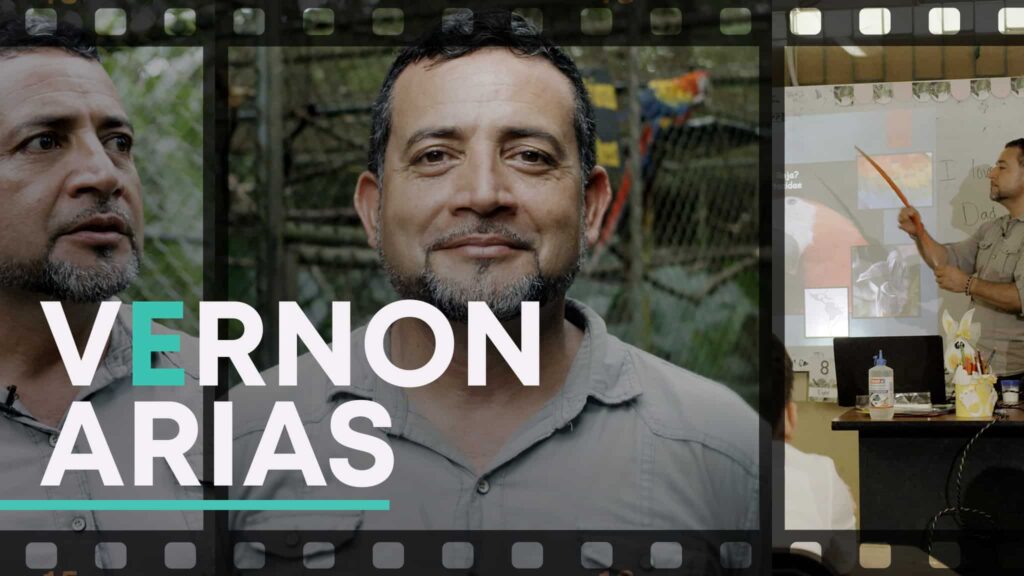Vernon Arias is a biologist based in Costa Rica’s Nicoya Peninsula, a region that was once filled with scarlet macaws, the largest parrots in the world.
However, due to the construction of tourist-attracting real estate, the scarlet macaws’ habitat was disrupted.

Couple this with the all-too-common practice of poaching the birds for sport, and the scarlet macaws are now an endangered species.
Through his work with non-profit organization ASOPROLAPA, Vernon is trying to change that.
He wishes to repopulate the Nicoya Peninsula with scarlet macaws, thus creating a healthier ecosystem, increasing wildlife tourism, and giving locals a sense of identity that was lost long ago.
How Did Vernon Arias Begin Working With Scarlet Macaws?
Hailing from the province of Cartago, Costa Rica, Vernon spent his childhood exploring nature.
His precocious fascination with the environment was the seed that eventually sprouted into his studying biology at The University of Costa Rica, one of Latin America’s most prestigious schools.
After earning his degree, he moved to the Guanacaste province to work with wild cats in captivity.

While working with wild cats, he continued to study biology independently, eventually learning of the plight of the scarlet macaw, a species that was facing extinction.
The more he read about scarlet macaws, the more his love and concern for them grew. Soon, he shifted his focus from wild cats to scarlet macaws.
He found ASOPROLAPA and began working with the organization.
What Do Vernon Arias and ASOPROLAPA Do?
ASOPROLAPA releases scarlet macaws back into the wild. These individuals then reproduce and repopulate the peninsula.
However, the release process is not as simple as it sounds. First, Vernon and his team instigate a scarlet macaw reproduction process, which happens within a well-protected hatchery.
After birth, the birds are nurtured until maturity, when, little by little, they are released into the wild.

Individuals that cannot be released, whether due to disabilities or problematic behaviors, are used for education of students and tourists.
Conservation education is another one of Vernon’s endeavors. He and his team speak to local schools about the biological roles of scarlet macaws, as well as the importance of wildlife conservation.
His commitment to being a positive influence on future generations has earned him quite the repertoire amongst local teachers and parents.
Vernon Arias on Funding ASOPROLAPA
As is the case with the majority of non-profit organizations, ASOPROLAPA is difficult to fund. However, the org has the advantage of being founded by an affluent real estate developer.

In 1996, the founder was given a few scarlet macaws—then exotic animals—as pets. After taking notice of the harmful effects his developments were having on the animals’ habitats, he decided to give back to the community, and thus, ASOPROLAPA was born, these few pet macaws being the oldest generation of birds the org has released.
To this day, the founder is the organization’s biggest source of funding, followed by donations from outsiders and tourists, who are enthralled to see scarlet macaws in the wild.
How Is Vernon Arias an Everyday Hero?
Vernon’s work benefits both the scarlet macaws and the local community. The species’ reintroduction to their habitat has given locals, the elderly members of which grew up seeing scarlet macaws in the wild, a sense of identity.
The birds’ presence has also increased tourism to the Nicoya Peninsula, therefore boosting the economy.

The conservation of scarlet macaws is important for the ecosystem, as the species feeds on a variety of plants.
While flying, they drop these plants’ seeds from their beaks, leading to the growth of oxygen-providing greenery. As Vernon puts it, they are “gardeners of the forest.”
What Is the Impact of Vernon Arias’s Work? What Are His Future Plans?
ASOPROLAPA has released approximately 200 scarlet macaws into the wild. These individuals have reproduced, and once again, the peninsula is teeming with the beautiful birds.
The birds’ presence is responsible for flourishing plant-life and a boost in tourism to the peninsula.
Vernon has already acted as a mentor to his students, teaching them about the importance of wildlife preservation and environmental sustainability.
Did You Miss Vernon Arias’ Feature Video?

He boosts their self-esteem by reminding them that each one of them has the ability to make a positive difference in their world.
Vernon believes that through this encouragement, future generations will be able to pick up and expand upon his work.
While the impact that Vernon and ASOPROLAPA has made on the Nicoya Peninsula is immeasurable, he aspires towards far more.
His current goal is to release 500 macaws into the wild, as well as to expand the org’s education program by speaking to more schools, hotels, and tourist resorts.
Vernon Arias Is a Hero
Because of Vernon and his teammates’ hard work, the Nicoya Peninsula is once again brimming with a beautiful bird that could very well have gone extinct.

Not only has he contributed to the saving of a species, he has brought happiness to the local population, who admire him for his commitment to conservation and education.
He has brought out the best in children, who, because of his teachings, understand the impact they can have on their local environment and red macaw population.